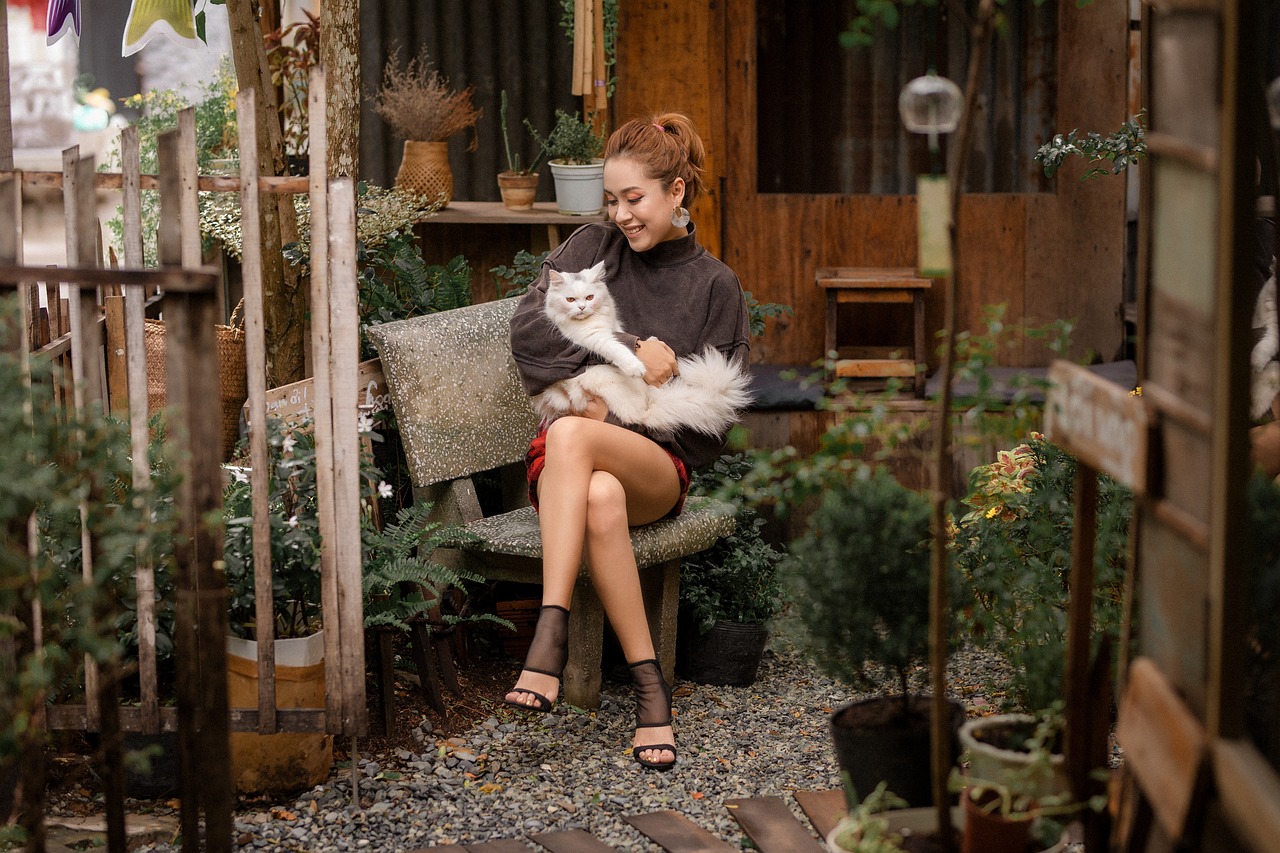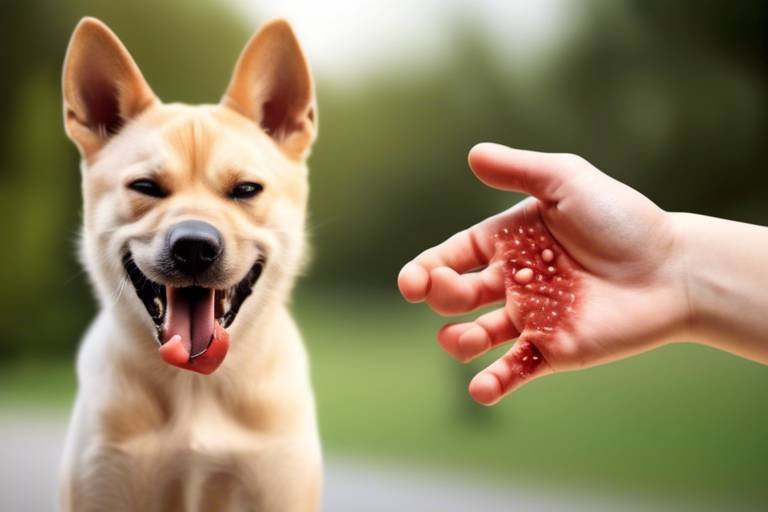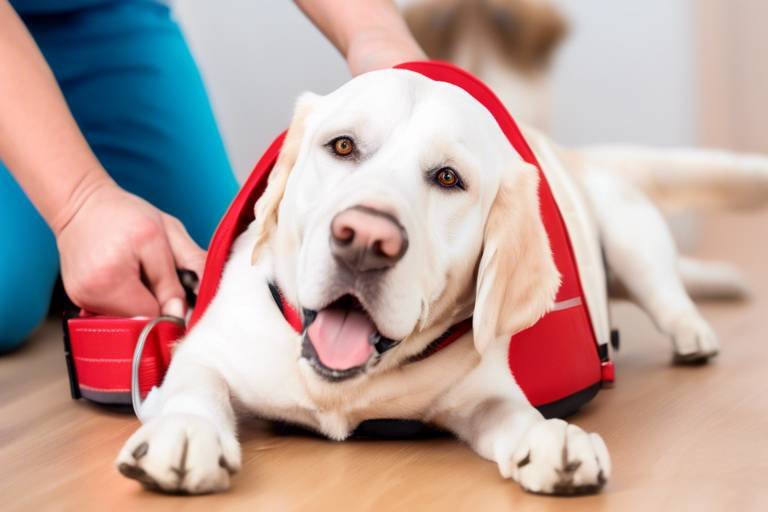How to Help Your Pet Cope with Stressful Situations
As pet owners, we often find ourselves in situations where our furry friends experience stress, whether it's due to loud noises, changes in their environment, or even visits to the vet. Understanding how to help them cope is not just beneficial for their well-being, but it's also essential for maintaining a harmonious relationship with them. Stress in pets can manifest in various ways, from excessive barking and hiding to destructive behavior and changes in appetite. The good news is that there are numerous strategies we can employ to assist our pets in managing their stress effectively. In this article, we’ll explore practical techniques and tips to ensure your beloved companions feel safe, secure, and loved during challenging times.
Recognizing the signs of stress in pets is crucial for effective intervention. Just like humans, pets can experience anxiety and discomfort, and it’s our responsibility to identify these signs early on. Common indicators of stress include:
- Excessive barking or meowing
- Hiding or seeking isolation
- Destructive behavior, such as chewing or scratching
- Changes in eating or drinking habits
- Excessive grooming or licking
Understanding these behaviors can help you take proactive measures to alleviate your pet's stress. Ignoring these signs can lead to more severe health issues, so it's essential to stay vigilant and responsive to your pet's needs.
A secure environment can significantly reduce a pet's anxiety. Just like we need a cozy nook to retreat to after a long day, pets also benefit from having their own safe space. This area should be a sanctuary where they can relax and feel protected from stressors. Consider designing a comforting space by incorporating elements that promote relaxation and security for your furry friend.
The location of your pet's safe space matters. Ideally, it should be a quiet corner of your home, away from the hustle and bustle. Think about areas like:
- Under a staircase
- A cozy corner in the living room
- A designated room with minimal foot traffic
It's important that this space is easily accessible to your pet, allowing them to retreat whenever they feel overwhelmed. The goal is to create an oasis where they can unwind and feel at ease.
Explore various calming products that can enhance your pet's safe space. Items such as pheromone diffusers, which release soothing scents, and anxiety wraps that provide gentle pressure, can significantly contribute to your pet's comfort. These products are designed to mimic the comforting sensation of being held, which can be incredibly effective in reducing anxiety during stressful situations.
Familiar items, like toys or blankets, can help ease anxiety. Integrating these beloved possessions into your pet's safe space can create a sense of familiarity and security. For instance, placing their favorite blanket or a cherished toy in their designated area can provide a comforting reminder of home. This simple act can make a world of difference in how your pet copes with stress.
A consistent routine can help pets feel secure. Just like children thrive on predictability, pets also benefit from a structured daily schedule. Regular feeding, exercise, and playtime can significantly reduce stress levels. By establishing a routine, you provide your pet with a sense of stability, allowing them to predict what comes next in their day. This predictability can be incredibly reassuring during times of uncertainty.
Training can play a vital role in helping pets cope with stress. It's not just about teaching commands; it's also about fostering a sense of confidence and calmness in your furry friend. By implementing specific training techniques, you can help your pet navigate stressful situations with greater ease.
Positive reinforcement is an effective training method that can work wonders in reducing stress. By rewarding calm behavior, you help your pet associate stressful situations with positive outcomes. For example, if your dog remains calm during a thunderstorm, offering treats or praise reinforces that behavior. This approach encourages them to stay relaxed, knowing that good things come when they handle stress well.
Gradual exposure to stressors can reduce anxiety. Desensitization techniques involve slowly introducing your pet to the sources of their stress in a controlled manner. For instance, if your pet is afraid of loud noises, you might play recordings of thunder at a low volume, gradually increasing the volume as they become more comfortable. This method can help your pet learn that these sounds are not harmful, ultimately reducing their fear.
Sometimes, professional intervention is necessary. If you notice that your pet's stress levels are consistently high or worsening, it may be time to consult a veterinarian or an animal behaviorist. They can provide tailored advice and support to help you manage your pet's stress effectively. Remember, seeking help is a sign of a responsible pet owner who wants the best for their furry companion.
Q: How can I tell if my pet is stressed?
A: Look for signs such as excessive barking, hiding, destructive behavior, or changes in eating habits.
Q: What are some calming products I can use?
A: Pheromone diffusers, anxiety wraps, and calming treats are great options to help soothe your pet.
Q: Is training effective for reducing pet stress?
A: Yes, positive reinforcement and desensitization techniques can significantly help pets cope with stress.
Q: When should I seek professional help for my pet?
A: If your pet's stress levels are consistently high or if their behavior changes dramatically, it's best to consult a professional.

Understanding Pet Stress
Recognizing the signs of stress in pets is crucial for effective intervention. Just like humans, our furry friends can experience a wide range of emotions, and stress can manifest in various ways. Have you ever noticed your dog pacing back and forth or your cat hiding under the bed? These behaviors are often indicators of stress, and understanding them can help you provide the support your pet needs.
Common signs of stress in pets include:
- Excessive barking or meowing: This can be a cry for help or a way to express discomfort.
- Aggression: Sudden changes in behavior, like growling or hissing, can indicate that a pet feels threatened.
- Destructive behavior: Chewing furniture or scratching walls may be a way for pets to cope with anxiety.
- Changes in appetite: A stressed pet might eat less or, conversely, overeat as a coping mechanism.
- Withdrawal: If your pet is hiding more than usual, it may be trying to escape from a stressful environment.
Understanding these signs is the first step in helping your pet manage stress. It's essential to remember that stress can stem from various sources, including changes in the household, loud noises, or even unfamiliar environments. For instance, a move to a new home can be as disorienting for a pet as it is for its owners. Just think about how you feel when you encounter a sudden change in your routine; pets experience similar feelings, and their reactions can be just as intense.
Moreover, the implications of untreated stress can be serious. Chronic stress can lead to health issues such as digestive problems, weakened immune systems, and even behavioral disorders. Therefore, being proactive about your pet's emotional well-being is not just beneficial—it's essential. By recognizing the signs early and understanding their causes, you can take steps to create a more peaceful environment for your beloved companion.
Ultimately, the goal is to ensure that your pet feels safe and secure in its surroundings. This means observing your pet closely and being attuned to its needs. Just like a good friend who knows when you need a shoulder to lean on, being aware of your pet's emotional state can help you provide the support it requires to navigate through stressful situations.

Creating a Safe Space
When it comes to helping our furry friends cope with stress, creating a safe space is one of the most effective strategies. Think of it as a cozy retreat where your pet can escape the chaos of the world and find solace. Just like how we seek comfort in our favorite chair or a quiet corner of the house after a long day, pets also need their own sanctuary where they can feel secure and relaxed. This safe space can be a designated area in your home that is free from loud noises, sudden movements, and other stressors.
To start, consider the location of this safe space. It should be a quiet area away from the hustle and bustle of daily life. Perhaps it’s a corner in your living room, a cozy nook in your bedroom, or even a spot in the basement where your pet can hide away. The key is to choose a place that feels comfortable and familiar for your pet. This designated area will serve as their personal haven, a place where they can retreat during times of stress.
Now that you have an idea of where to set up your pet's safe space, let’s talk about what makes a location ideal. Here are a few tips to consider:
- Avoid High-Traffic Areas: Choose a spot that isn’t frequently visited by family members or guests. This will help minimize disturbances.
- Keep It Cozy: Ensure the area is warm and inviting. You can add a soft blanket or bed to make it more appealing.
- Ensure Accessibility: Make sure your pet can easily access this space whenever they need it. If you have a small dog, for example, don’t place their safe space too high up or in a location that requires jumping.
To enhance the comfort of your pet's safe space, consider incorporating calming products. These can include pheromone diffusers, which release soothing scents that can help alleviate anxiety. Additionally, anxiety wraps are another great option; they provide gentle pressure that can have a calming effect on pets. You can also use calming music or white noise to drown out any sudden sounds that might trigger stress. By creating an environment filled with these comforting elements, you can significantly improve your pet's ability to relax.
Another essential aspect of creating a safe space is the use of familiar items. Just like how a child might feel better with their favorite stuffed animal, pets also benefit from having their beloved toys or blankets nearby. These items carry their scent and provide a sense of security. When setting up the safe space, consider adding:
- Favorite Toys: Include a few of your pet's favorite toys to provide comfort and distraction.
- Blankets or Beds: Use soft, familiar bedding to create a cozy atmosphere.
- Personal Items: If your pet has a specific item that they love, like a shirt or a small pillow, include that in their safe space.
By integrating these familiar elements, you’re not only making the space more inviting but also helping your pet associate it with positive feelings and relaxation. Remember, the goal is to create a sanctuary where your pet feels safe and protected during stressful times.
In conclusion, creating a safe space for your pet is a vital step in helping them manage stress. By choosing the right location, using calming products, and incorporating familiar items, you can build an environment that promotes relaxation and emotional well-being. Your pet deserves a little slice of tranquility in their life, and with your help, they can find it right at home.
Choosing the Right Location
When it comes to creating a safe space for your pet, the location is everything. Imagine being in a crowded room where the noise is overwhelming; you'd want a quiet corner to retreat to, right? Pets feel the same way! The right spot in your home can make a world of difference in helping your furry friend feel secure and relaxed during stressful moments.
First, consider areas that are naturally quiet and away from the hustle and bustle of daily life. Think about locations like a cozy corner in your living room, a quiet bedroom, or even a designated nook in a less-trafficked area of your home. These spots should be free from loud noises, sudden movements, and other potential stressors. It’s essential to create a space where your pet can escape and unwind without interruption.
Additionally, the temperature and lighting of the location matter significantly. A spot that is too hot or too cold can add to your pet's discomfort. Aim for a place that is well-ventilated and maintains a comfortable temperature. Natural light can be soothing, but avoid placing your pet's safe space in direct sunlight for extended periods, as this can lead to overheating. If your pet feels too exposed, consider using curtains or a pet tent to create a more enclosed environment.
Moreover, consider the accessibility of the chosen location. Your pet should be able to reach this safe space easily, especially during moments of anxiety. If your pet is older or has mobility issues, placing their safe zone on the ground floor can be a thoughtful choice. You want to ensure that they can retreat to their safe haven without any obstacles in their way.
Lastly, think about how you can make this location feel even more special. Adding a few of your pet's favorite items can help transform the area into a comforting retreat. A soft blanket, a couple of their favorite toys, or even a piece of your clothing can provide a sense of familiarity and security. It’s like wrapping them in a warm hug when they need it the most!
In summary, choosing the right location for your pet's safe space involves a blend of quietness, comfort, and accessibility. By being mindful of these factors, you can create an environment where your pet can feel truly at ease, even during the most challenging times.
- What signs indicate that my pet is stressed? Look for behaviors like excessive barking, hiding, panting, or changes in eating habits.
- Can I use calming products in any location? It's best to use calming products in your pet's designated safe space for maximum effectiveness.
- How do I know if my pet feels safe in their space? If they frequently retreat to that area and exhibit relaxed body language, it’s a good sign!
- Is it okay to change my pet's safe space location? Yes, but make sure the new location still meets their needs for comfort and security.
Using Calming Products
When it comes to helping our furry friends navigate through stressful situations, calming products can be a game changer. Just like we might sip a soothing cup of chamomile tea after a long day, pets can benefit from various products designed to alleviate their anxiety. These products range from pheromone diffusers to anxiety wraps, each offering unique benefits that cater to different types of stressors.
One of the most popular options is the pheromone diffuser. This product releases synthetic versions of the calming pheromones that mother animals produce to comfort their young. When used in your home, these diffusers can create a serene atmosphere, helping your pet feel more at ease. Imagine walking into a room filled with a gentle, reassuring scent that instantly makes you feel at home; that’s what these diffusers aim to achieve for your pet.
Another effective tool is the anxiety wrap. These snug garments apply gentle pressure to your pet's body, similar to a hug, which can have a calming effect. Think about how you might feel when wrapped in a cozy blanket during a thunderstorm. Anxiety wraps work on the same principle, providing a sense of security. It's particularly helpful during events like fireworks or loud noises that can trigger panic in pets.
In addition to these products, there are also natural supplements available, such as calming treats infused with ingredients like chamomile or valerian root. These can be offered to your pet before a stressful event, like a vet visit or a long car ride. However, it's always best to consult with your veterinarian before introducing any new supplements to your pet's regimen.
To make the most of these calming products, it’s important to integrate them into your pet's routine effectively. For instance, starting the diffuser a few hours before a known stressor can create a calming environment in advance. Similarly, dressing your pet in an anxiety wrap well before the event can help them get used to it and benefit from its calming effects. Remember, just as every human has different preferences for relaxation, each pet may respond uniquely to these calming products.
In conclusion, utilizing calming products can significantly enhance your pet's safe space and help them cope with stress. By creating a soothing environment with these tools, you not only provide comfort but also show your pet that they are loved and secure.
- What are pheromone diffusers? Pheromone diffusers release synthetic pheromones that mimic natural calming scents to help reduce anxiety in pets.
- How do anxiety wraps work? Anxiety wraps apply gentle pressure to your pet, providing a sense of security and comfort, similar to a hug.
- Are natural supplements safe for my pet? While many natural supplements are safe, it's essential to consult with your veterinarian before introducing them to your pet's diet.
Incorporating Familiar Items
When it comes to helping your pet feel safe and secure, familiar items can work wonders. Just like how a child's favorite blanket can soothe their fears, pets also find comfort in objects that hold special meaning to them. Think about it: Have you ever noticed how your dog snuggles up to their favorite toy or how your cat curls up in their beloved blanket? These items not only provide physical comfort but also evoke feelings of safety and familiarity. So, how can you effectively incorporate these cherished items into your pet's safe space?
First and foremost, consider what items your pet is most attached to. This could be a favorite toy, a worn-out blanket, or even an old piece of your clothing that carries your scent. Pets are incredibly intuitive and can often sense the emotional connection we have with certain objects. By introducing these items into their safe space, you create an environment that feels less intimidating and more like home.
Here are some effective ways to integrate familiar items into your pet's safe area:
- Placement: Strategically place these items within the safe space. For example, if your dog loves a particular stuffed animal, make sure it’s easily accessible in their designated area. This encourages them to seek it out whenever they feel anxious.
- Comfort Layers: Create a cozy bed or resting area using their favorite blanket. Layering their comfy items can enhance the sense of security, making it a perfect retreat for your furry friend.
- Interactive Toys: If your pet has a favorite interactive toy, like a puzzle feeder, include it in their safe space. This not only distracts them from stressors but also keeps their mind engaged, which can be incredibly beneficial during anxious moments.
Additionally, it's important to rotate these familiar items periodically. Just like us, pets can get bored with the same objects over time. By introducing different familiar items, you keep their environment fresh and engaging, which helps maintain their interest and comfort. You might even find that switching things up offers a new layer of excitement for your pet, turning their safe space into an ever-evolving sanctuary.
Lastly, don’t underestimate the power of your presence. Sitting with your pet in their safe space while they explore their familiar items can reinforce their sense of security. Your calm demeanor can be incredibly reassuring, and it shows them that they are not alone during stressful times. Remember, the goal is to create a warm, inviting atmosphere where your pet can retreat and feel at ease, surrounded by the things they love most.
Establishing a Routine
Establishing a routine for your pet is not just about creating a schedule; it's about fostering a sense of security and predictability in their lives. Just like humans, pets thrive on consistency. When they know what to expect, it alleviates anxiety and helps them feel more at ease. Think of it as a comforting rhythm that they can rely on, much like a favorite song that plays at the same time every day.
Start by setting regular feeding times. This simple act can create a sense of stability in your pet’s day. For instance, if you feed your dog at 8 AM and 6 PM, they will begin to anticipate these moments, reducing their stress. In addition, make sure to provide fresh water throughout the day, as hydration is key to their overall well-being.
Next, incorporate regular exercise into your routine. Exercise is not just vital for physical health; it plays a crucial role in mental stimulation and stress relief. A daily walk or play session can help your pet burn off excess energy and reduce anxiety levels. For example, a 30-minute walk in the morning followed by some playtime in the evening can work wonders for their mood. Remember, a tired pet is often a happy pet!
Moreover, don't forget about playtime. Engaging in fun activities not only strengthens your bond but also serves as a great outlet for their energy. Whether it’s a game of fetch in the backyard or a cozy cuddle session with their favorite toy, these moments are essential for emotional health. You might even consider setting aside specific times for training; this not only reinforces good behavior but also provides mental stimulation.
Finally, try to maintain a consistent bedtime routine. Just like children, pets benefit from knowing when it’s time to wind down. A calming routine before bed can help signal to your pet that it’s time to relax. This may include a gentle brush, some quiet time, or even a short cuddle session. By establishing a predictable routine, you’re helping your pet feel safe and secure, which is crucial during stressful times.
In summary, a well-structured routine can significantly reduce your pet's stress levels. By focusing on regular feeding, exercise, playtime, and a calming bedtime routine, you're not just managing their anxiety; you're enhancing their overall quality of life. Remember, a happy pet leads to a happy home!
- How long does it take for a routine to help reduce my pet's stress?
It can vary depending on the pet, but consistency over a few weeks typically shows noticeable improvements in their behavior and anxiety levels. - What if my pet resists the routine?
Start slowly and gradually introduce changes. Positive reinforcement can encourage them to adapt to the new routine. - Are there specific activities that help reduce stress for pets?
Yes! Activities like walks, playtime, and training sessions are great for mental and physical stimulation.

Training Techniques for Stress Reduction
When it comes to helping our furry companions deal with stress, training can be an absolute game-changer. Just like humans, pets can feel overwhelmed in various situations, and the right training techniques can empower them to face their fears with confidence. Imagine your pet, once skittish during thunderstorms or anxious during vet visits, now calmly lounging on the sofa, unbothered by the world around them. Sounds dreamy, right? Well, it’s possible!
One of the most effective methods in this training arsenal is positive reinforcement. This technique involves rewarding your pet for displaying calm behavior, which helps them associate stressful situations with positive outcomes. For instance, if your dog remains calm during a loud noise, shower them with praise or a tasty treat. Over time, they’ll learn that being relaxed is the way to go. It’s like giving them a little gold star for their bravery! Remember, consistency is key. The more you reinforce this behavior, the more likely it is to stick.
Now, let’s talk about another powerful tool in your training toolkit: desensitization strategies. This approach involves gradually exposing your pet to the stressor in a controlled manner. For example, if your dog is afraid of fireworks, you might start by playing recordings of fireworks at a low volume while engaging them in a fun activity like playing with their favorite toy. As they become more comfortable, you can slowly increase the volume. It’s like teaching them to dance with their fears instead of running away from them!
Here’s a quick overview of how to implement these techniques:
| Technique | Description | Example |
|---|---|---|
| Positive Reinforcement | Rewarding calm behavior to encourage relaxation. | Praising your dog when they stay calm during a thunderstorm. |
| Desensitization | Gradual exposure to stressors to reduce anxiety. | Playing recorded fireworks sounds at a low volume. |
Training isn’t just about commands and tricks; it’s about building a bond of trust and security between you and your pet. Think of it as a bridge that connects their worries to a place of comfort. As you embark on this journey together, you’ll not only help them cope with stress but also strengthen your relationship. It’s a win-win!
Finally, don’t hesitate to seek out resources or professional help if you feel stuck. Sometimes, a little guidance from a trainer or behaviorist can make all the difference. Remember, the goal is not to eliminate stress completely but to equip your pet with the tools to handle it gracefully. After all, life is full of surprises, and it’s our job as pet parents to prepare them for whatever comes their way!
- What are common signs of stress in pets? Look for behaviors like excessive barking, hiding, or destructive actions.
- How long does it take for training to be effective? Every pet is different, but consistency and patience can lead to noticeable improvements in a few weeks.
- Can I use training techniques for all types of pets? Yes, most training techniques can be adapted for different types of pets, including cats and rabbits.
Positive Reinforcement
Positive reinforcement is a powerful tool in the pet training toolbox, and it can make a world of difference when it comes to helping your furry friend cope with stress. Imagine this: every time your pet faces a challenging situation, you reward them for calm behavior. This creates a direct link in their mind between the stressful event and a positive outcome, which is incredibly reassuring for them. It’s like giving them a little treat for being brave! So, how exactly do you implement this strategy?
First and foremost, it’s essential to identify the specific behaviors you want to encourage. Is your dog anxious during thunderstorms? Or does your cat hide when guests arrive? Once you pinpoint these stress-related behaviors, you can start rewarding the calm reactions instead. For instance, if your dog remains relaxed during a storm, shower them with praise or a tasty treat. This not only reinforces their calmness but helps them associate the storm with something positive.
Consistency is key when utilizing positive reinforcement. Make sure to reward your pet every time they exhibit the desired behavior. Over time, this will help them build confidence and reduce their overall anxiety. It’s also important to choose rewards that are meaningful to your pet. Here’s a quick breakdown of effective reinforcement options:
| Type of Reward | Description |
|---|---|
| Treats | Small, tasty snacks that your pet loves can be a great motivator. |
| Praise | Verbal praise and affection can be just as rewarding as food. |
| Playtime | Engaging in a favorite game or activity can serve as a fantastic reward. |
Another aspect to consider is timing. The sooner you reward your pet after they display calm behavior, the more effective the reinforcement will be. This helps them make the connection between the behavior and the reward clearer. Think of it this way: if you wait too long, it’s like trying to reward a child for doing their homework a week later—it just doesn’t make sense!
In addition to rewarding calmness, you can also use positive reinforcement to teach your pet coping mechanisms. For example, if your pet starts to exhibit signs of stress, you can guide them to a designated safe space and reward them for going there. This not only reinforces their safe zone but also helps them learn to manage their anxiety independently.
Ultimately, positive reinforcement is about building trust and a sense of security between you and your pet. By consistently rewarding calm behavior, you’re not just helping them cope with stress; you’re also fostering a deeper bond. Remember, every pet is unique, so be patient and observant as you explore what works best for your furry companion. With time and effort, you’ll help them navigate stressful situations with greater ease and confidence.
- What is positive reinforcement? Positive reinforcement is a training method that involves rewarding desired behaviors to encourage their repetition.
- How can I tell if my pet is stressed? Common signs of stress in pets include excessive barking, hiding, panting, and changes in appetite or behavior.
- Can all pets benefit from positive reinforcement? Yes, positive reinforcement can be effective for a wide range of pets, including dogs, cats, and even small animals like rabbits.
- How long does it take to see results? Results can vary, but with consistent practice, many pet owners notice improvements in their pet’s behavior within a few weeks.
Desensitization Strategies
When it comes to helping our furry friends cope with stress, can be a game-changer. Just like humans, pets can develop anxieties that stem from specific triggers, whether it's loud noises, new environments, or even unfamiliar people. The key to desensitization is to gradually expose your pet to these stressors in a controlled manner, allowing them to build confidence over time.
Imagine this process as taking baby steps. Instead of throwing your pet into a chaotic situation, you start small and slowly increase the exposure. For instance, if your dog is afraid of thunderstorms, you might begin by playing a recording of thunder at a very low volume while engaging them in a fun game. This way, they can associate the sound with positive experiences rather than fear. Over time, you can gradually increase the volume as your pet becomes more comfortable.
It's essential to monitor your pet's reactions during these sessions. If they show signs of distress, such as panting, whining, or attempting to escape, it's a signal to dial back the exposure. Patience is crucial; desensitization is not an overnight fix. It requires consistency and a gentle approach. As you proceed, ensure that you reward your pet with treats or praise whenever they remain calm, reinforcing the idea that facing their fears leads to positive outcomes.
Here are some additional tips to enhance your desensitization efforts:
- Start with the least frightening version: For example, if your pet is scared of car rides, begin by simply sitting in the parked car with them, rewarding them for being calm.
- Use distractions: Engage your pet with their favorite toys or treats during exposure sessions to divert their attention from the stressor.
- Keep sessions short: Aim for brief exposure periods, gradually increasing the duration as your pet becomes more comfortable.
Moreover, it's important to remember that every pet is unique. What works for one may not work for another. Therefore, always tailor your approach to fit your pet's individual temperament and needs. If you notice significant progress, celebrate those small victories! These moments can significantly boost your pet's confidence and help them feel more secure in their environment.
In some cases, desensitization may require the guidance of a professional trainer or behaviorist, especially for pets with severe anxiety. They can provide tailored strategies and support to ensure that your pet is on the right path to overcoming their fears.
Ultimately, desensitization is about building trust and helping your pet feel safe. With time, effort, and a little creativity, you can help your furry friend navigate their fears and enjoy a more relaxed and happy life.

Seeking Professional Help
Sometimes, despite our best efforts, our furry friends may still struggle with stress that we cannot manage alone. This is where seeking professional help becomes essential. Just like humans, pets can experience overwhelming emotions that require expert intervention. If you notice that your pet's anxiety is persistent or worsening, it may be time to consult a veterinarian or an animal behaviorist. These professionals are trained to understand the complexities of animal behavior and can offer tailored strategies to help your pet cope.
When considering professional help, it's important to recognize the signs that indicate your pet needs more support than you can provide. Look out for symptoms such as:
- Excessive barking or meowing
- Destructive behavior
- Loss of appetite
- Increased aggression or withdrawal
- Frequent accidents in the house
If you observe these behaviors, don’t hesitate to reach out for help. A veterinarian can rule out any underlying health issues that may be contributing to your pet's stress. They can also recommend appropriate treatments, which may include medication or behavioral therapy. On the other hand, an animal behaviorist specializes in addressing behavioral problems and can work with you to develop a comprehensive plan tailored to your pet’s specific needs.
In some cases, a combination of both veterinary care and behavioral strategies may be necessary. For instance, if your pet's stress is linked to a medical condition, treating that condition might alleviate their anxiety. Here’s a simple table that outlines when to seek professional help:
| Signs of Stress | Action to Take |
|---|---|
| Persistent anxiety | Consult a veterinarian |
| Behavioral changes | Contact an animal behaviorist |
| Physical health symptoms | Visit your vet for a check-up |
| Combination of issues | Seek both veterinary and behavioral advice |
Remember, seeking help is not a sign of failure; it’s a proactive step towards ensuring your pet's emotional well-being. Just like we might need a therapist to navigate our own stress, our pets can benefit from the expertise of professionals who understand their unique challenges. Investing in your pet's mental health can lead to a happier, more balanced life for both of you.
Q: How do I know if my pet is stressed?
A: Signs of stress can include excessive barking, destructive behavior, hiding, or changes in eating habits. If you notice any of these signs, it may be time to seek help.
Q: What should I expect during a visit to a veterinarian for stress-related issues?
A: The vet will conduct a thorough examination, ask about your pet's behavior, and may suggest treatment options, including medication or referrals to behavior specialists.
Q: Can stress in pets be treated without medication?
A: Yes, many pets can benefit from behavioral training, environmental changes, and calming products, but in some cases, medication may be necessary.
Q: How long does it take for a pet to feel better after starting treatment?
A: The timeline varies depending on the individual pet and the treatment plan, but many pets start showing improvement within a few weeks.
Frequently Asked Questions
- What are the signs that my pet is stressed?
Pets can’t verbally express their feelings, but they sure have their ways of showing stress! Look for signs like excessive barking, hiding, panting, or even changes in eating habits. If your furry friend is acting out of character, it might be time to pay close attention.
- How can I create a safe space for my pet?
Creating a safe haven for your pet is all about comfort! Choose a quiet corner of your home, away from noise and chaos. Add their favorite blanket, toys, and maybe even a cozy bed. Think of it as their little retreat where they can chill and feel secure.
- Are there specific calming products I can use?
Absolutely! There are a variety of calming products designed specifically for pets. Pheromone diffusers can mimic natural calming scents, while anxiety wraps provide gentle pressure that can soothe them. It's like a warm hug for your pet during tough times!
- How important is routine for my pet's stress levels?
Routine is key! Just like us, pets thrive on consistency. Regular feeding, exercise, and playtime can make them feel more secure and reduce anxiety. It’s as if you’re giving them a little roadmap to navigate their day!
- What training techniques can help my pet manage stress?
Training can be a game-changer! Positive reinforcement helps your pet associate calm behavior with rewards, making them more likely to stay relaxed. Plus, using desensitization strategies can gradually help them face stressors without freaking out. It’s like building their confidence one step at a time!
- When should I seek professional help for my pet?
If you notice persistent signs of stress or if your pet's behavior becomes concerning, it might be time to consult a veterinarian or an animal behaviorist. They can provide tailored advice and strategies to help your pet feel better. After all, sometimes we all need a little expert guidance!



















